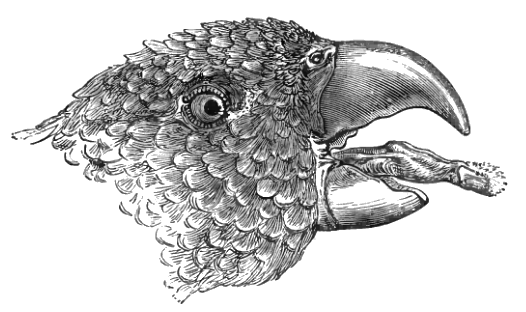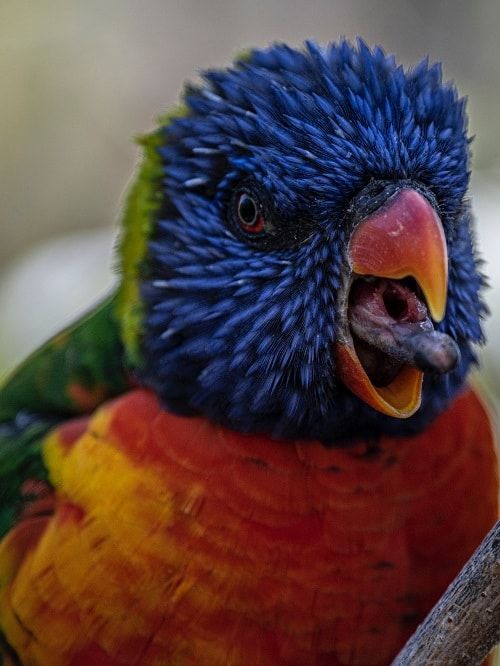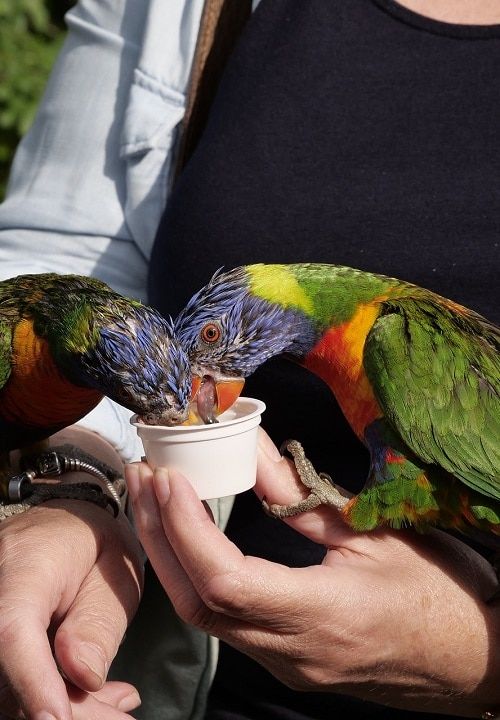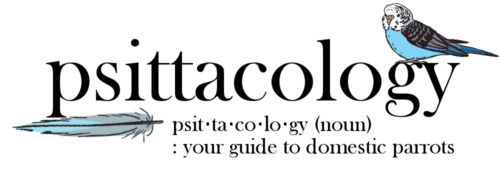Let’s talk lorikeets and lories! These Australasian parrots have an unusual diet and they’ve evolved to adapt to it perfectly. This has led to the lorikeet tongue being the strangest one in the parrot world, and it’s also what makes the different species of lories and lorikeets more challenging to keep at home.
Keep reading for everything you need to know about lorikeet tongues, lorikeet diet and what these birds are like as pets.
What is a lorikeet?
Lorikeets are parrots. Specifically, they’re members of the tribe Loriini along with their very close cousins, the lories. There are about 60 species in total between the two, of which around 40 are lorikeets.
The lorikeets make up the most commonly known genus Trichoglossus, which includes the popular rainbow lorikeet. The other genera of lorikeets are Psitteuteles, Vini, Glossopsitta, Parvipsitta, Charmosyna, Oreopsittacus and Neopsittacus. Most of these are not commonly kept as pets, though some are!
Lorikeets are found all over Australasia. Rainbow lorikeets, the most well-known species, are native to Australia, whereas other lorikeets naturally occur in Indonesia, New Guinea and a bunch of other islands.
All lorikeet species are medium-sized and beautifully colored. The rainbow lorikeet especially is a common and hugely popular bird in its native land, with many people putting out feeders to attract them to their gardens.
Did you know? The difference between a lory and a lorikeet is like that between a parrot and a parakeet. You can read more in the article on lory vs lorikeet!

Lorikeet tongue & diet
Now, let’s discuss what everyone’s been waiting for: the utterly weird lorikeet tongue. The scientific name of the genus Trichoglossus kind of sums it up. It basically means ‘hairy tongue’!
Most lorikeets naturally eat a diet consisting of flower nectar, pollen and/or soft foods like fruits. In fact, in their native lands, these guys can be a huge headache for farmers and orchard owners. They love descending on crops and making quick work of them.
In order to be able to reach that delicious nectar and pollen, lorikeet (and lory) species have evolved a long and flexible tongue. The tip of the tongue features a sort of ‘brush’ that helps them access the best bits of their favorite flowers, notably Eucalyptus.
Did you know? Lorikeets are highly adapted. They have a shorter, less muscular gizzard and shorter intestinal tract than other parrots. This makes them highly efficient at digesting nectar and pollen but ineffective at digesting harder foods like seeds or insects.
Richardson & Wooller, 1990
Lorikeets and lories don’t exclusively eat nectar and pollen, but it does make up a major part of many species’ diet. Other foods they’ll consume include softer fruits like figs, hibiscus and coconut. In addition, they’ll also eat some types of seeds and insects or their larvae.
What does a brush-tipped tongue actually look like? Well, pretty much like this 19th-century illustration of a lory:

Feeding lorikeets
If you live in Australia or another area where lorikeets naturally occur (or were introduced, like in Hong Kong), you can attract them to your garden with a bird feeder.
Do make sure you feed the right types of food: bread, honey, jam and other highly sugary ‘human foods’ will not sustain lorikeets. In fact, feeding them leads to problems in the development of baby birds.
The absolute best and most natural thing you can do is plant native bushes and trees in your garden, like the big favorite Eucalyptus or bottlebrushes. Other options include store-bought lorikeet food for pet lorikeets, fresh fruits and fresh veggies. Don’t forget plenty of fresh water either!
Don’t be alarmed if you see some pretty intense-looking territorial squabbles going on at your feeder. Lorikeets are pretty feisty and will try to eject other birds, including species like magpies, from their favorite feeding spots.
Did you know? In 2015, Australian bird experts were baffled by rainbow lorikeets visiting a bird feeding station that contained minced meat for carnivorous birds. On top of that, the lorikeets were very protective of the mince, even though the species had never been observed to have a taste for meat before.
Rainbow lorikeets eating meat leaves bird experts astonished

Lorikeets as pets
The fact that lorikeets are naturally curious and will do anything for a lick of nectar has made them the star of many a zoo. Give visitors a cup with some lorikeet food and they’ll soon be covered in hungry birds. A memorable experience!
Do lorikeets also make good domestic pets? Well, that all depends on your poop tolerance. And a few other things, but mainly your poop tolerance. You see, a liquid diet leads to liquid poops. Unless you manage to potty train your lorikeet (which is possible), this poop will end up all over your house. It might also be sprayed out of the cage.
In general, lorikeets make very fun pets. They’re super high energy and it’s hard not to go along with their hopping, playing and chatter.

Here are some basic lorikeet facts:
- Lorikeets are loud. They naturally live in flocks that are very social and need to be able to find each other in the treetops. Expect chatter, screeching and lots of whistling. Not ideal if your walls are thin.
- Lorikeets need a lot of attention. They’re extremely social and love to spend time with their human. Hanging out, training, playing: a lorikeet is sure to keep you busy. Lonely lorikeets are prone to plucking, excessive screaming and other unwanted behaviors.
- Lorikeets need a lot of space. Seriously, these guys can bounce off the walls sometimes. A small cage is not gonna cut it, for example, nor is a life without plenty of daily out-of-cage time. Inside the cage, lots of toys are a must.
- Lorikeets need a specialized diet. Their food spoils quickly and you need to be on top of things at all times. This is why they’re generally not recommended for beginning parrot enthusiasts.
- Lorikeets are territorial. They don’t really play nice with other parrots. Without proper training, they’re also likely to nip at you from time to time.
To conclude, if you have some experience training parrots and plenty of time to spend with your lorikeet, you can definitely consider adding one to your family. The downsides are made up for by the fact that a properly trained and happy lorikeet is just so much fun to be around.
Life with a lorikeet is never boring. They’re incredibly smart and can learn to perform tricks or even talk quite well.
Did you know? Some lorikeet owners report their noses and ears occasionally being mistaken for flowers. Part of owning a lorikeet is accepting that sometimes you’ll be caught off guard with a bird tongue in your ear!
If you have any more questions about the strangeness of a lorikeet tongue, lorikeet diet or keeping these parrots as pets, don’t hesitate to leave a comment below!
Cover photo: © michaklootwijk on Adobe Stock
Lorikeet with flower photo: © Jonathan Densford on Adobe Stock
Sources


Like parrots and parakeets, lories and lorikeets are differentiated by the length and shape of their tails. Lories and parrots have a shorter, rounded shaped tail and parakeets have a long, tapered tail.
That’s right! For those who want to know more about this, there’s also an article on lories vs lorikeets. 🙂
Hi Mari,
This article was posted to the Australian Native Animals Facebook group. I wanted to thank you for a very informative and fun description of the birds I see a great deal. I live in the Blue Mountains about one hour west of Sydney and there are wild flocks of Rainbow Lorikeets flying and screeching around our homes. This is a bird watchers paradise and there are many others species visiting our neighborhoods. Cockatoos, Galahs, King Parrots, Bower birds, and of course, Kookaburras. I encourage you to visit one day if you haven’t already. You will love our unique, beautiful mountains!
I’m glad you liked the article! What a dream, that sounds amazing 🙂
I remember coming to the blue mountains at 3.5 years old and remember the bird life. 44 now. But will be back one day
Say hi to the lorikeets for me if you go!